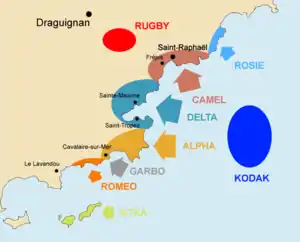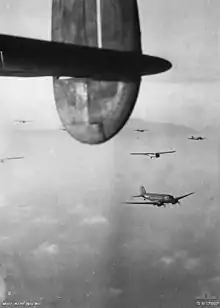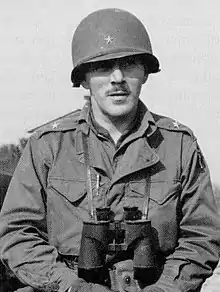| 1st Airborne Task Force | |
|---|---|
| Active | 11 July – 23 November 1944 |
| Country | |
| Allegiance | Allies of World War II |
| Branch | |
| Type | Airborne forces |
| Role | Parachute infantry |
| Size | 9,000 |
| Engagements | Operation Dragoon |
| Commanders | |
| Notable commanders | Robert T. Frederick |
The 1st Airborne Task Force was a short-lived Allied airborne unit that was active during World War II created for Operation Dragoon–the invasion of Southern France. Formed in July 1944, under the command of Major General Robert T. Frederick, it took part in the "Dragoon" landings on 15 August 1944, securing the area north-west of the landing beaches, before moving towards the French–Italian border as part of the United States Seventh Army. The unit was disbanded in November 1944.
Formation
In the initial plans for the invasion of France it was proposed that two forces would land simultaneously in Normandy and in southern France in June 1944, attacking the Germans from the north and south in a classic pincer movement, after which the southern forces would head east to aid Allied forces in Italy. However it was soon realized that there were not enough landing ships or men available to carry out both operations at the same time, so the southern invasion ("Operation Anvil") was postponed. The southern invasion (now "Operation Dragoon") was planned for August 1944, and all airborne forces were allocated to a new unit formed on 11 July 1944 as the Seventh Army Airborne Division (Provisional). This was redesignated the 1st Airborne Task Force on the 21st.[1]
In order to form the 1ABTF airborne units were withdrawn from combat in Italy. These were the U.S. 509th Parachute Infantry Battalion and U.S. 517th Parachute Regimental Combat Team, and the British 2nd Independent Parachute Brigade. Added to them were the U.S. 550th Glider Infantry Battalion and U.S. 551st Parachute Infantry Battalion, both of which had previously been stationed in Panama, and neither of which had seen combat. Two Free French parachute battalions had originally been assigned in early July, but disagreements over their deployment with General de Gaulle meant that the troops were not made available,[2] and so the British 2nd Parachute Brigade was assigned to the operation on the proviso that they would be returned to operations in Italy once the beachhead was firmly established.[3]
Operation Dragoon

1ABTF's part in "Dragoon", was codenamed "Operation Rugby". They were to land around the village of Le Muy, midway between Draguignan, and the landing beaches at Fréjus–Saint-Raphaël.[4] There were three Drop Zone/Landing Zones:
- The British 2nd Parachute Brigade were assigned an area of open fields and vineyards, designated DZ/LZ "O", 400 yards north of Le Muy on the northern side of the Nartuby River.[5] The 550th Airborne Infantry Battalion would also land there later in the day.[3]
- The U.S. 517th PRCT were assigned an area of narrow fields about two miles west of Le Muy, designated DZ/LZ "A", south of the Nartuby River.[5] The 1st Battalion, 551st Parachute Infantry Regiment would follow later in the day.[3]
- The 509th PIB and the 463rd Field Artillery were assigned an area, designated DZ "C", about two miles south-east of Le Muy. This area, lying in a basin between two ridges with hills to the east and west, was steep, rocky, and wooded, with only small areas of level and open ground at either end. It was reluctantly chosen in order to put troops on the high ground dominating Le Muy from the south.[5]
The landings


On the night of the operation heavy fog meant that the initial landings were scattered over a wide area, and by dawn only about 60% of the task force troops had assembled in their drop zones. The gliders bringing the British artillery support at 08:00 had to abort their mission, though landings and drops later in the day were more successful. Many gliders were damaged on landing, but casualties were generally light.[4][6]
In combat
While the village of Le Muy itself remained in enemy hands,[4] the British secured the high ground to the east and north, while the Americans did the same in the west and south. The 550th Battalion attempted to secure Le Muy that night, but were repulsed.[7] Apart from seizing the village, the 1ABTF had completed its assigned mission, establishing a strong position astride the Argens valley preventing the enemy advancing on the beach-head.[4] On the morning of the 16th the 550th attacked Le Muy again, and by 14:45 it was taken – between 500 and 700 prisoners were captured.[8] Early on the morning of the 17th forward elements of the U.S. 36th Division arrived at Le Muy from the beach-head, and then continued their advance towards Draguignan.[7]
Following "Operation Rugby" the 1ABTF moved north-east, covering the right flank of the Seventh Army, and liberating Cannes and Nice, before being deployed to the Maritime Alps in a static role, mounting patrols and keeping a close watch on the Germans in the area of the Franco-Italian border.
The 2nd (Independent) Parachute Brigade was released on 26 August 1944. Six weeks later it was deployed to Greece.[9] In November 1944 1ABTF was sent to Soissons to rest and refit, and was disbanded on 23 November 1944,[10] with most of the units being attached to the XVIII Airborne Corps.[11]
Order of battle
Main force
The 1ABTF was composed of the following units:[12]

- 1ABTF HHC – Maj. Gen. Robert T. Frederick
- U.S. 509th Parachute Infantry Battalion – Lt. Col. William P. Yarborough
- 463rd Parachute Field Artillery Battalion – Lt. Col. John Cooper
- U.S. 517th Parachute Regimental Combat Team
- 517th Parachute Infantry Regiment – Col. Rupert D. Graves
- 460th Parachute Field Artillery Battalion – Lt. Col. Raymond L. Cato
- 596th Airborne Engineer Company – Capt. Robert W. Dalrymple
- U.S. 550th Airborne Infantry Battalion (Glider) – Lt. Col. Edward I. Sachs
- U.S. 551st Parachute Infantry Battalion – Lt. Col. Wood G. Joerg
- 602d Glider Field Artillery Battalion – Maj. George M. Hunt
- British 2nd (Independent) Parachute Brigade – Brig. Charles Hilary Vaughan Pritchard [detached 26 August]
- 4th Parachute Battalion – Lt. Col. H.B. Coxen
- 5th (Scottish) Parachute Battalion – Lt. Col. D.R. Hunter
- 6th (Royal Welch) Parachute Battalion – Lt. Col. V.W. Barlow
- 1st Independent Parachute Platoon (Pathfinders)[13]
- 1st Special Service Force (U.S./Canada) – Col. Edwin A. Walker [attached 22 August]
Support units
- 512th Airborne Signal Company
- 887th Airborne Engineer Aviation Company
- Antitank Company, 442nd Infantry Regiment
- 552nd Antitank Company[note 1]
- Company A, 2nd Chemical Mortar Battalion
- Company A, 83d Chemical Mortar Battalion
- Detachment, 3d Ordnance Company
- 676th Medical Collecting Company
Base support units
- 3358th Quartermaster Truck Company
- 334th Quartermaster Depot Company
- 172d Detail Issues Depot, British Heavy Aerial Resupply Company
- 904th Air Base Security Battalion
Airlift units
- Provisional Troop Carrier Air Division – Gen. Paul L. Williams
Fighter Support
- 31st FG (13 August 1944 ~ 16 August 1944)
See also
Notes
- ↑ The 552nd Antitank Company was formed in July 1944, in Rome, specifically for this operation. Since the 442nd became available while the 552nd was in training and took very little time to train on the British 6lb. guns needed for gliders, it went in first. But the 552nd was always on the complement of troops slated for this operation (and the 1st ABTF) and relieved the 442nd mid-October 1944 supporting the 1st ABTF member units still in the area.[14]
References
- ↑ Warren (1955), p. 91.
- ↑ Warren (1955), p. 94.
- 1 2 3 Warren (1955), p. 103.
- 1 2 3 4 Clarke, Jeffrey J.; Smith, Robert Ross (1992). European Theater of Operations: Riviera to the Rhine. United States Army in World War II. Washington, D.C.: Center of Military History, United States Army. Retrieved 27 February 2011.
- 1 2 3 Warren (1955), p. 83.
- ↑ Warren (1955), p. 95.
- 1 2 Elphick, Robert (2009). "The Liberation of Fayence – August 1944". The Riviera Reporter. Archived from the original on 18 October 2011. Retrieved 27 February 2011.
- ↑ Warren (1955), p. 108–109.
- ↑ Ferguson, Gregor (1987). Paras – British Airborne Forces 1940–1984. Osprey. p. 14. ISBN 978-0-85045-573-1.
- ↑ Rinaldi, Richard A. "U.S. Glider Infantry in World War II" (PDF). Orders of Battle. Archived from the original (PDF) on 14 July 2010. Retrieved 21 February 2011.
- ↑ "US Airborne Formations 1942–45". First Allied Airborne Association. 2010. Archived from the original on 18 January 2012. Retrieved 21 February 2011.
- ↑ Cross, Thomas R. (2007). "Airborne Invasion of Southern France – Operation Dragoon". 517th Parachute Regimental Combat Team. Archived from the original on 15 March 2012. Retrieved 27 February 2011.
- ↑ "1st Independent Parachute Platoon". Airborne Assault ParaData. Archived from the original on 25 July 2011. Retrieved 27 February 2011.
- ↑ From documents in the National Archives.
Bibliography
- Warren, John C. (1955). Airborne Missions in the Mediterranean, 1942–1945 (PDF). USAF Historical Study No. 74. Archived from the original (PDF) on 22 July 2011. Retrieved 27 February 2011 – via Air Force Historical Research Agency.
Further reading
- Archer, Clark L. (1985). Paratroopers Odyssey : A History of the 517th Parachute Combat Team. Hudson, Florida: 517th Parachute Regimental Combat Team Association. ISBN 0961601507.
- Astor, Gerald (1993). 'Battling Buzzards': The Odyssey of the 517th Parachute Regimental Combat Team 1943-1945. New York: D. I. Fine. ISBN 0440236932.
- Breuer, William B. (1987). Operation Dragoon: The Allied Invasion of the South of France. Novato, California: Presidio Press. ISBN 0891413073.
- De Trez, Michel (1998). First Airborne Task Force: Pictorial History of the Allied Paratroopers in the Invasion of Southern France. Wezembeek-Oppem: D-Day Publishing. ISBN 2960017625.
- Gassend, Jean-Loup (2014). Operation Dragoon: Autopsy of a Battle: The Allied Liberation of the French Riviera, August-September 1944. Atglen, Pennsylvania: Schiffer Publishing. ISBN 978-0764345807.